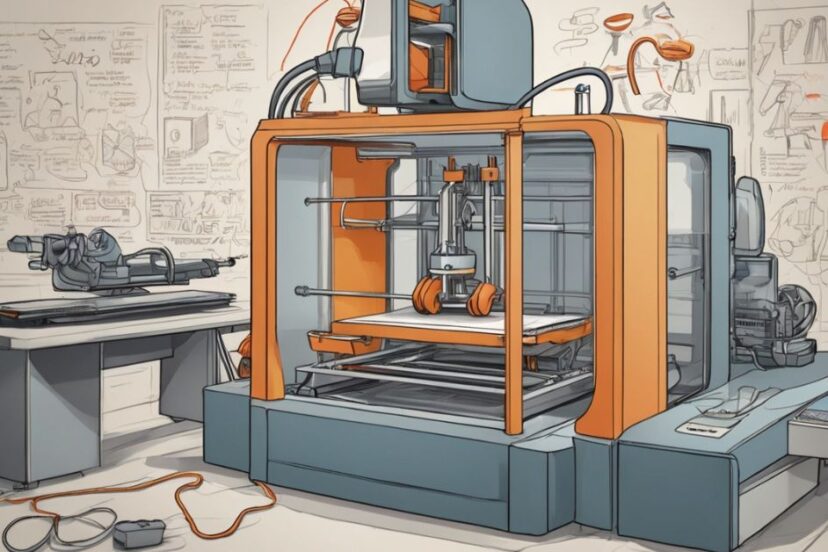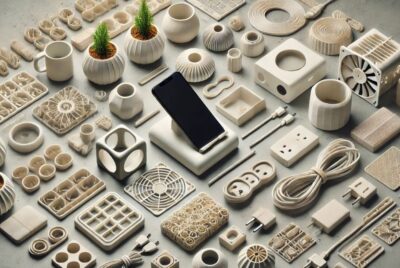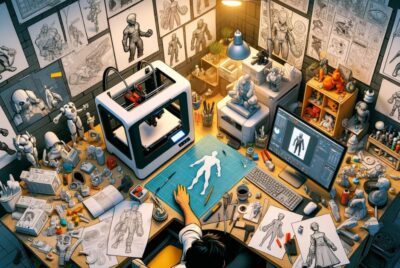Top 3D Printed Products to Sell: A Guide for Success
In an era where technology drives innovation at a breakneck pace, 3D printing emerges as a beacon of transformative potential. This technology has not only revolutionized manufacturing across industries but has also opened up unprecedented opportunities for entrepreneurs and small businesses. Why is 3D printing such a game changer? It democratizes the production of goods, offering a lower barrier to entry for creating and selling products worldwide. Imagine designing a product from the comfort of your home in New York and selling it in Tokyo, Berlin, or Cape Town without ever setting up a traditional factory. This is the power of 3D printing!
The market for 3D printed goods is expanding rapidly, fueled by the continuous advancements in 3D printing technology and materials. From intricate jewelry and custom prosthetics to functional automotive parts and architectural models, the possibilities are virtually limitless. But it’s not just the diversity of products that makes 3D printing appealing; it’s the ability to start a business with minimal upfront costs, personalize products to meet customer needs, and scale quickly based on demand.
Whether you’re a seasoned maker looking to monetize your skills or a newcomer intrigued by the digital fabrication revolution, selling 3D printed products offers a path to creative fulfillment and financial success. In this guide, we will explore why 3D printing is a lucrative venture, what products you can sell to capture the market, and how to navigate the challenges of this exciting industry. Let’s uncover how you can turn layers of printed material into layers of opportunity.
This introduction aims to captivate the reader’s interest by emphasizing the innovative and transformative aspects of 3D printing, setting a strong foundation for the rest of the article. If there’s anything specific you’d like to include or further modify, just let me know!
Why Sell 3D Printed Products?
3D printing isn’t just a manufacturing innovation; it’s a doorway to numerous business opportunities that tap into various markets from medical devices to fashion accessories. Why should you consider selling 3D printed products? Here are several compelling reasons:
Customization at Its Core
At the heart of 3D printing’s allure is its ability to customize. Whether it’s personalizing a gift or tailoring a gadget to specific needs, customization can set your products apart in a crowded marketplace. This capability allows you to cater to niche markets where customers are willing to pay a premium for products that are perfectly suited to their requirements.
Rapid Prototyping
The agility to swiftly move from design to prototype is invaluable, especially in today’s fast-paced market. 3D printing allows you to iterate designs without the hefty costs and time constraints associated with traditional manufacturing methods. This means you can test ideas and get feedback quickly, refining products in real-time to better meet consumer expectations.
Cost-Effective Manufacturing
Starting a business usually involves significant upfront investment, particularly for inventory. However, with 3D printing, you can operate on a ‘print-on-demand’ basis, reducing the need to hold large volumes of stock. This significantly lowers the risk and overhead costs, making it an attractive option for startups and entrepreneurs.
Access to Expanding Markets
The 3D printing industry is expected to grow exponentially, with applications expanding across various sectors including healthcare, automotive, and education. By entering this market now, you position yourself at the forefront of a technology that’s set to revolutionize how we create and consume products.
Sustainability
Environmental sustainability is increasingly becoming a priority for consumers. 3D printing promotes less waste compared to traditional manufacturing processes, as it only uses the material necessary to build the product. Moreover, the ability to use eco-friendly materials like biodegradable plastics can appeal to eco-conscious consumers, giving your business a competitive edge.
Educational and Creative Opportunities
Selling 3D printed products also presents an opportunity to educate and inspire. By hosting workshops or creating content around the design and printing process, you can engage with your community, spread knowledge about this innovative technology, and inspire others to explore their creativity.
Choosing the Right Niche
Entering the world of 3D printing with a clear focus can significantly enhance your chances of business success. But with such a vast array of possibilities, how do you determine the right niche for your 3D printing venture? Here are essential strategies to guide your decision:
Analyze Market Demand
The first step in selecting a niche is understanding where the demand lies. Conduct market research to discover which 3D printed products consumers are searching for. Look for trends on social media, check out best-selling items on platforms like Etsy or Amazon, and use tools like Google Trends to identify what people are interested in. Are customers looking for personalized home decor, bespoke jewelry, or unique educational tools? Pinpointing these interests can help you focus your efforts where there is proven demand.
Identify Gaps in the Market
While it’s important to recognize where the demand is, finding success often comes from identifying and filling gaps in the market. Are there customer needs that are not being fully met by current offerings? Perhaps there’s a demand for eco-friendly 3D printed products, or maybe there’s a niche for custom 3D printed orthotics. By addressing these gaps, you can create a unique value proposition that sets your business apart.
Leverage Your Skills and Interests
Your niche should ideally align with your own skills, interests, and expertise. If you have a background in engineering, you might excel in creating functional mechanical parts. If art is your passion, bespoke sculptures or jewelry could be your niche. Aligning your business with your strengths not only makes the work more enjoyable but also imbues your products with a level of authenticity and quality that customers will notice.
Consider Profitability
Not all 3D printed products will have the same profit margins. Some items, like intricate jewelry, can command higher prices; others, due to material costs and competition, may offer slimmer margins. When choosing your niche, consider the profitability of the products. Analyze material costs, production time, and potential selling prices to ensure that the niche you select can be financially sustainable.
Test the Waters
Before fully committing to a niche, consider running a small-scale test. Produce a limited quantity of your product and gauge the market’s response. Use online marketplaces or social media platforms to sell your items and collect customer feedback. This real-world data can provide invaluable insights and help you refine your product before scaling up.
Top 3D Printed Products to Sell
Here are some of the top-selling 3D printed products that you can consider for your business:
Toys
Toys remain a popular category for 3D printed items, with a variety of innovative and customizable options that cater to both children and adult collectors.
Products to Consider:
- Tic Tak Gun: A novel take on a classic game, this product is not only fun but also interactive, making it a top seller.
- Fidget Slider: Capitalizing on the fidget toy trend, this product offers a satisfying sensory experience that appeals to both kids and adults looking to relieve stress.
- Mushroom Dice Castle: Perfect for board game enthusiasts and role-playing gamers, this intricately designed castle serves as both a game piece and a decorative item.
- Dinosaur Set: A hit among younger children, this set allows for imaginative play and educational opportunities, teaching kids about different dinosaur species.
Jewelry
Jewelry is a highly personalized niche where customers often seek unique pieces that stand out.
Products to Consider:
- Specific jewelry items are not listed, but consider creating custom pendants, earrings, and bracelets that can be personalized for individual tastes. Use intricate lattice work or geometric patterns that are difficult to replicate with traditional manufacturing methods.
Home Decor
3D printed home decor items offer a blend of functionality and aesthetic appeal, perfect for customers looking to customize their living spaces.
Products to Consider:
Again, specific items are not detailed in the list, but potential products include:
- Vases: Create vases with complex designs that can be customized in color and size to fit any room.
- Wall Art: Offer personalized 3D printed wall sculptures that can feature abstract shapes or personalized motifs.
Gadgets and Tech Accessories
This niche taps into the tech-savvy consumer market, offering practical and stylish solutions to everyday problems.
Products to Consider:
While specific gadgets are not mentioned, ideas include:
- Phone Cases: Design customizable phone cases with unique textures or features like extra grip or built-in stands.
- Cable Organizers: Simplify your customers’ digital lives with sleek, efficient organizers that keep cables neatly arranged.
Educational Tools
3D printed educational tools can be both functional and engaging, providing interactive learning experiences for all ages.
Products to Consider:
- Educational toys from the list like the Mushroom Dice Castle could double as educational tools, teaching strategy and probability.
Marketing Your 3D Printed Products
Marketing is crucial for the success of any business, especially in a niche as innovative and specific as 3D printing. Here are several strategies to effectively market your 3D printed products and make your business stand out:
Build a Strong Online Presence
Website and Online Store: Your website is often the first point of contact with potential customers. Make sure it is visually appealing, easy to navigate, and optimized for search engines (SEO). Highlight the uniqueness of your products with high-quality images and detailed descriptions.
Social Media Engagement: Platforms like Instagram, Pinterest, and Facebook are ideal for showcasing the visual appeal of 3D printed products. Regular posts featuring new designs, behind-the-scenes processes, and customer reviews can help build a community and engage potential customers. Consider using targeted ads to reach a broader audience.
Leverage Content Marketing
Blogging: Create a blog on your website where you post articles related to 3D printing, such as “How It Works,” “The Future of 3D Printing,” and “Unique 3D Printed Gifts for Every Occasion.” This not only establishes your authority in the field but also improves your site’s SEO, drawing more traffic.
Video Marketing: Videos can be incredibly effective, especially for showing the 3D printing process or the final product in use. Platforms like YouTube, TikTok, and Instagram Reels are perfect for sharing engaging video content.
Utilize Customer Feedback
Testimonials and Reviews: Showcase customer testimonials prominently on your website and social media. Positive reviews build trust with potential customers and can significantly influence buying decisions.
User-Generated Content: Encourage customers to share photos and videos of your products in use. This not only provides you with free marketing material but also demonstrates real-life applications of your products.
Offer Promotions and Discounts
Limited-Time Offers: Create urgency with time-limited offers or launch special promotions during holidays and special events. This can boost sales and attract new customers.
Discounts on Bulk Orders: Offering discounts on bulk purchases can attract larger orders and is particularly effective for B2B customers or resellers.
Participate in Trade Shows and Craft Fairs
Exposure: Attending trade shows and craft fairs can significantly increase the visibility of your products. These events provide an opportunity to interact directly with potential customers, receive immediate feedback, and even showcase the technology.
Networking: Use these events to connect with other businesses and potential collaborators who might offer new distribution channels or partnership opportunities.
Collaborate with Influencers and Bloggers
Influencer Partnerships: Partner with influencers who align with your brand to reach a wider audience. An influencer’s endorsement can lend credibility and expand your reach, particularly in niche markets.
Product Reviews: Send your products to bloggers and YouTubers for review. This can be an effective way to gain exposure in your target market, especially if the reviewers have a significant following in the tech or design communities.
Setting Up Your Online Store
Creating an online store is a crucial step for selling your 3D printed products. Here’s how to set it up effectively to attract customers and streamline operations:
Choose the Right Platform
E-commerce Platforms: Select a platform that suits the size and scope of your business. Shopify and WooCommerce are popular choices because they offer extensive customization options, integrated payment solutions, and scalability. For those targeting handmade and craft-oriented markets, platforms like Etsy can also be a good fit.
Design for Usability and Aesthetics
User-Friendly Design: Ensure that your online store is easy to navigate. Organize products into clear categories and use filters to help customers find what they are looking for quickly. The checkout process should be straightforward, with minimal steps to reduce cart abandonment.
Professional Look: Invest in high-quality images and a professional design. Your website’s visual appeal can greatly influence a customer’s decision to purchase. Consider hiring a professional photographer and a web designer to create a compelling online presence.
Optimize for Mobile
Mobile Optimization: With an increasing number of consumers shopping on their smartphones, it’s critical that your online store is optimized for mobile devices. This means fast load times, responsive design, and accessible navigation.
Integrate Secure Payment Options
Payment Security: Offer a variety of secure payment methods, including credit cards, PayPal, and other mobile payment solutions like Apple Pay or Google Pay. Ensure that your platform is PCI compliant to safeguard personal information.
Implement SEO Best Practices
Search Engine Optimization: Use keywords relevant to your products and industry in your product descriptions, blog posts, and meta tags to improve your store’s visibility on search engines. Regularly updating your content and using blog posts to answer common questions related to your niche can also boost your SEO.
Set Up Analytics
Track Performance: Use tools like Google Analytics to track your store’s performance. Understanding where your traffic comes from and how customers interact with your site can help you make informed decisions that enhance user experience and increase sales.
Manage Inventory and Logistics
Inventory Management: Even if you operate on a print-on-demand basis, it’s important to track your materials and production capacity to fulfill orders efficiently. Consider inventory management software that integrates with your e-commerce platform.
Shipping and Fulfillment: Decide whether you will handle shipping in-house or use a third-party logistics provider. Offer various shipping options and be transparent about timelines and costs.
Provide Excellent Customer Service
Support Channels: Implement a reliable customer service system that includes live chat, email, and phone support. Quick and helpful customer service can significantly enhance customer satisfaction and loyalty.
Market Your Store
Launch Campaign: When your store is ready to go live, launch it with a marketing campaign. Use email marketing, social media, and paid advertising to draw attention. Offering launch promotions or discounts can encourage visitors to make their first purchase.
Setting up an online store for your 3D printed products involves careful planning and attention to detail in both technical and customer-focused areas. By following these guidelines, you can create a user-friendly, efficient, and visually appealing online presence that showcases the uniqueness of your products and attracts a broad audience.
Success Stories
Discovering the journeys of those who have successfully navigated the world of 3D printing can provide both inspiration and valuable lessons. Here are a few success stories from individuals and businesses that have made a significant impact with their 3D printed products.
The Story of Nervous System
Background: Nervous System is a design studio that pioneered the integration of technology and nature to create jewelry and home decor items. Founded by Jessica Rosenkrantz and Jesse Louis-Rosenberg, both graduates of MIT, the studio uses algorithms inspired by natural phenomena to generate unique product designs.
Success Factors: What sets Nervous System apart is their innovative use of generative design processes that simulate natural growth patterns. Their ability to offer customers the chance to participate in the design process by customizing their purchases has made them a standout in the market.
Outcome: Today, Nervous System’s products are sold worldwide, and their designs have been featured in major publications and exhibitions, highlighting the potential of combining art, science, and 3D printing.
MakerBot’s Revolution
Background: MakerBot, one of the early startups in the consumer 3D printing market, was founded by Bre Pettis, Adam Mayer, and Zach “Hoeken” Smith. They started with the goal of making 3D printers more accessible to the general public.
Success Factors: The key to MakerBot’s success was its open-source approach, which encouraged a community of developers to share designs and improvements. Their user-friendly and affordable 3D printers appealed to educators, designers, and hobbyists, broadening the market beyond industrial users.
Outcome: MakerBot significantly influenced the popularity of 3D printing and was eventually acquired by Stratasys in 2013 for $403 million, showcasing the lucrative potential of the consumer 3D printing market.
Custom Orthotics by Wiivv
Background: Wiivv is a start-up that leverages 3D printing technology to create custom-fit orthotics and footwear tailored to the individual’s biomechanics. Founded by Shamil Hargovan and Louis-Victor Jadavji, the company uses a smartphone app to capture the customer’s feet in 3D.
Success Factors: Wiivv’s success lies in its combination of technology, convenience, and customization. By enabling customers to scan their feet at home using just their smartphones, Wiivv offers a personalized product that significantly enhances comfort and support.
Outcome: Wiivv has successfully raised millions in funding and has expanded its product line to include custom-fit sandals, showing the demand for personalized health and wellness products.
These stories not only serve as testament to the vast potential of 3D printing across different markets but also illustrate key strategies that can be employed for success: innovation, community engagement, and personalized customer experiences. Let these stories inspire you as you embark on your own journey in the world of 3D printing.
Conclusion
As we’ve explored the dynamic world of 3D printing and the myriad opportunities it presents, it’s clear that this technology isn’t just about what can be created—it’s about the possibilities it opens up for entrepreneurs and innovators. Whether you are drawn to the customization potential of home decor, the personal touch in jewelry making, or the innovation in gadgets and educational tools, 3D printing offers a pathway to transform your creative ideas into tangible successes.
Embarking on a 3D printing business requires not just creativity and technical skill, but also a strategic approach to choosing the right niche, understanding your market, and effectively promoting your products. The journey may be fraught with challenges, from selecting the perfect product to mastering the nuances of digital marketing, but the rewards can be substantial. Remember, every successful 3D printing entrepreneur started with a single print and a big dream.
Use the insights from the success stories we’ve shared to fuel your ambition—let them remind you that with perseverance, a willingness to learn, and a readiness to adapt, you can carve out your own space in the booming 3D printing market. As technology continues to evolve, so too will the opportunities for innovative and enterprising individuals.
So, take the lessons learned, harness the potential of 3D printing, and push the boundaries of what’s possible. Your next big success might just be one layer of filament away. Start small, think big, and keep printing towards your dreams!
FAQs
- What is the initial investment to start selling 3D prints?
The initial investment for starting a 3D printing business can vary significantly based on the quality of the printer, the type of materials used, and the scale of your operations. A basic entry-level 3D printer can cost anywhere from $200 to $1,000, while professional-grade models may range from $1,000 to over $10,000. Additionally, costs for materials, design software, and a workspace need to be considered. On average, you could start a small-scale 3D printing business with an initial investment of $2,000 to $5,000. - How do I price my 3D printed products?
Pricing 3D printed products should account for material costs, time spent on design and printing, machine wear and tear, and your desired profit margin. A common approach is to calculate the cost of materials and energy per item, add a markup for time and labor (often 2x to 3x the material cost), and then factor in overhead costs like software, maintenance, and amortization of the printer. Additionally, market research is essential to ensure your prices are competitive yet profitable. - What are the best platforms to sell 3D printed items?
Popular platforms for selling 3D printed items include Etsy for custom and artistic products, eBay for a broader audience, and Amazon if you can handle larger volumes. For specialized items, consider platforms like Shapeways or Sculpteo, which also offer print-on-demand services. Building your own eCommerce website can also be beneficial, especially if you wish to build a brand and have more control over customer interactions. - How can I ensure the quality of my 3D prints?
Ensuring the quality of your 3D prints involves several steps:
• Regularly maintain and calibrate your 3D printer to ensure it operates at optimal settings.
• Use high-quality materials and verify that they are suitable for the type of products you are printing.
• Perform post-processing steps such as sanding, painting, or sealing to enhance the finish and durability of the prints.
• Conduct quality checks on each item before shipping, including strength tests and visual inspections. - What are the legal considerations for selling 3D printed products?
When selling 3D printed products, consider the following legal aspects:
• Copyrights and Trademarks: Ensure you have the rights to reproduce and sell designs, especially if they are based on existing characters or products.
• Product Liability: You may be liable if your product fails and causes harm, so consider liability insurance and rigorous product testing.
• Business Licensing and Tax: Depending on your location, you may need a business license and need to collect sales tax on items sold.




